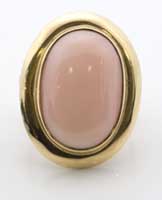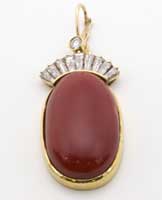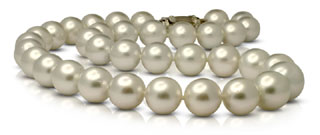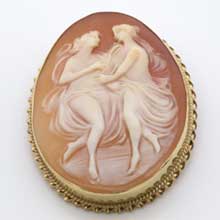Organic Gems
Gemstones are the focus of much of jewelry's beauty and value, but some gems are not "stones" at all. Organic gems come from once-living plants and animals. These non-"stone" gems have their own separate valuation criteria, durability issues and imitations.
Coral
Here's a gem material with serious historical punch: amulets of red coral have been found in Neolithic graves dating back to 8000 BC. Today coral is used for necklaces, earrings and brooches, as well as dramatic table sculptures.
 |
 |
Angel Skin Coral 14K yellow gold ring $850 |
Red Coral & Diamond 18K yellow gold pendant $4,500 |
Coral comes from thousands of individual coral polyps, each polyp only a few millimeters in diameter. For protection, each polyp secretes a protective jacket of calcium carbonate. As the colony builds these shells, they couple together into branches and, if large enough, reefs. It is these calcium carbonate structures that are the gem material.
Dark red and oxblood coral have been the most desirable for jewelry, but connoisseurs also value a delicate shade of pink called "angel skin." Yet the desirable colors are increasingly difficult to find because all coral supplies are suffering from industrial pollution, oil spills, thermal stress caused by heated discharge from power plants, overharvesting of the coral, and careless and destructive harvesting.
As supplies of fine red coral go down, prices go up, and imitations and adulterations increase. Some dealers are dyeing colorless coral to a reddish shade that experts recognize as fake; this might fool the inexperienced appraiser or buyer, and most certainly the insurer. According to some experts, 90-95% of the new coral entering the market is color-enhanced.
Another scam involves combining shavings of coral branches with a chemical binding agent, then selling the product as genuine coral. Rank imitations, including shell and plastic, are also passed as coral.
True coral is sensitive to detergents, perfumes, chemicals and even body acids. Gemologists and dealers recommend that coral be cleaned periodically in a mild soapy solution to rid it of these abrasives.
Pearls
This most popular organic gem is produced in the soft tissue of a mollusk. Since ancient times freshwater pearls have been harvested from rivers and lakes, and saltwater pearls from coastal ocean beds. Only a small portion of pearls harvested were of a shape, color and quality to be used in jewelry.

South Sea Cultured Pearls
17-inch strand
$35,000
Over the last century, the development of pearl cultivation techniques has revolutionized the pearl industry. Gem-quality pearls are now produced in huge quantities. Technology allows coloring pearls to pink, blue, gray, green, golden, or chocolate, to meet—or create—the latest fashion. This classic gem once available only to royalty and the wealthy is now a favorite for affordable jewelry. (See our May 2007 issue for a more detailed discussion of pearls.)
Ivory
Ivory comes from the tusks and teeth of animals such as the elephant, walrus, hippopotamus and sperm whale. There is also fossilized ivory, sometimes called ancient ivory, from the tusks of woolly mammoth and mastodon.
Humans have carved ivory into personal ornaments (as well as art works and utilitarian objects) since prehistoric times. Contemporary jewelry using ivory is rare. The rapid decline of ivory-producing animals and the cruel practices of poachers caused many countries to ban the importation and sale of ivory. Plastics and other imitations have moved in to fill the gap.
Shell
Cameo engraving on shell enjoyed a golden age in the Greco-Roman empires, then fell out of fashion until the art was revived in the Renaissance. Carvers favor particular species of shell that have a white or pale surface layer and a reddish to brownish inner layer. The two distinct layers allow the figures in relief to stand out. The small relief sculptures, which have changed little over the centuries, are made into bracelets, earrings, pendants and brooches.

Shell Cameo
set in 18K yellow gold brooch mounting
$725
In cameo-carving areas of Italy, artisans train from age 13 to produce the delicate works. These days, manufacturers may use automated lasers to carve cameos, but such manufactured works do not command the high prices of hand-carved pieces.
Amber
Amber is the fossilized resin of pine trees that lived about 45 million years ago. The ancient Greeks compared it to hardened tears or rays of sunset. Its warm yellow-red-orange color, as well as its easy workability, made amber a popular jewelry material over the centuries.

8 oval amber cabochons
in 14K yellow gold bracelet
$400
Unlike diamond and most other gems, where inclusions lower the value, amber derives character from its inclusions of miniscule air bubbles or fossilized insects or plants. Amber material is comparatively soft, splinters under a knife, is somewhat soluble in alcohol, and burns with resin-like fumes. Whatever the value and beauty, it's not a great candidate for insurance against damage.
Jet & Gutta-Percha
Victorian mourning customs, with their emphasis on proper (mainly black) clothing for the proper period of time, made black-gem jewelry popular in the mid-19th century. Jet, which is fossilized coal, was the first choice. Gutta-percha was a less expensive alternative. Victorian "mourning jewelry" employing jet and gutta-percha can still be found in antique markets.

Gutta-Percha brooch
with yellow gold center containing one seed pearl
$290
The highly malleable sap of the gutta-percha tree was not only made into lockets, brooches and walking-cane heads, it was also used to insulate telegraph wires, make golf balls, create molded furniture that imitated carved wood, and produce dental fillings and a variety of surgical devices. Contemporary plastics have replaced gutta-percha in most of these uses.
Tortoise Shell
Tortoise shell is not actually shell. It is the carapace of the hawksbill sea turtle and is chemically similar to horn. The hawksbill is now a protected species, but for several centuries its shell was a popular material for jewelry and hair ornaments. Today the term "tortoise shell" generally refers less to a gem than to a color pattern on some common material, such as plastic.
Bugs, Claws & Hair, Oh My!
Other jewelry materials have also passed out of use. The stylized form of the scarab beetle is often found in metal and gemstone jewelry, but during the period known as the Egyptian Revival the insect itself was a popular jewelry item. The beetles were carefully dried, perhaps coated with lacquer, and made into brooches, earrings or pendants. Reports say such jewely was surprisingly durable.
Tiger claw jewelry is sometimes seen in the antique market. It dates from the British colonial period in India, when tiger-hunting was encouraged. Taxidermists mounted the heads, furriers used the pelts, and jewelers set the claws in brooches and pendants.
Jewelry made of human hair was popular in England and America during the Victorian period. Young women crafted hair-work items from pattern books, and avid collectors today comb the antique markets for such pieces.
FOR AGENTS & UNDERWRITERS
Things to keep in mind:
The gems discussed here are generally low-priced, compared with diamond. However, the jewelry may be of high value because it is expertly crafted and made of expensive metal.
Many of these materials are easily damaged — amber is soft, coral can be eaten away by chemicals and body acids, cameos made of shell may discolor over time, etc. This amounts to inherent vice.
Remember that words like unique, antique, Victorian, etc., are merely descriptive terms (or hype) — they say nothing about the jewelry's value. (See the October 2005 issue for detailed discussion.)
Many of these gems have high name recognition and might be assumed to be more expensive than they are. Tourists, for example, may overpay for exotic jewelry because they buy on the enthusiasm of the moment with no research or comparison shopping. Also, plastic imitations abound.
Assigning value to unusual pieces requires skill and experience. Be sure the appraiser is a jeweler who regularly deals in such jewelry and is familiar with the pricing (and scams) in its specialized market.
For scheduled jewelry, have a competent trained appraiser, preferably a Graduate Gemologist who is also a Certified Insurance Appraiser™, determine valuation and supply a detailed descriptive appraisal on JISO 78/79.
To schedule or not?
It may happen that a policyholder has a jewelry collection that is valuable as a whole, but the value of each piece is, say, under $1,000. Should you schedule this jewelry?
Consider:
- There are clerical expenses on the front end and adjustment expenses in case of loss.
- The cost of adjusting a $500 item is the same as for a $10,000 item. It may be cheaper just to pay the loss.
- There may be enough coverage (typically $500-$2500) under the Homeowners policy to cover theft, but--
- The Homeowners policy does not cover mysterious disappearance, breakage or chipping.
- Jewelry made of materials that are highly vulnerable to damage should not be insured.
FOR ADJUSTERS
Always have damaged jewelry inspected in a gem lab by a graduate gemologist who has experience with the gem material involved. Some materials can change or break down under normal wear and tear, and such changes are not considered damage for which the insurer is liable.
Most materials discussed here are low in value. If the appraised valuation is high, be sure to check the sales receipt. A large discrepancy is a strong indication of inflated valuation or fake.
For high-value jewelry, check the appraiser's record and experience. Does he regularly deal with high-value jewelry? Does he have experience with this type of jewelry? Have other appraisals of his been inflated? You may want to consult a jewelry insurance professional to help resolve these questions.
©2000-2025, JCRS Inland Marine Solutions, Inc. All Rights Reserved. www.jcrs.com

